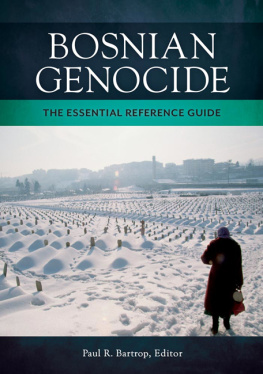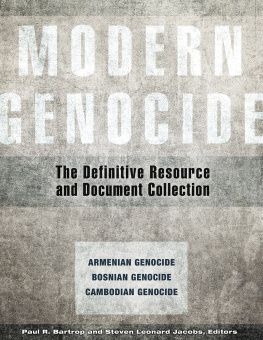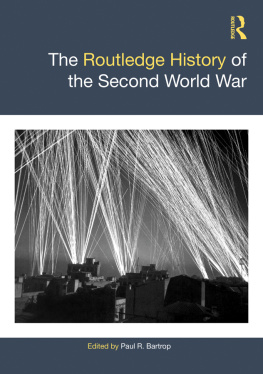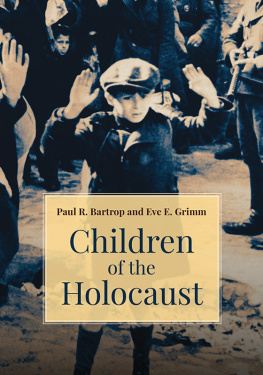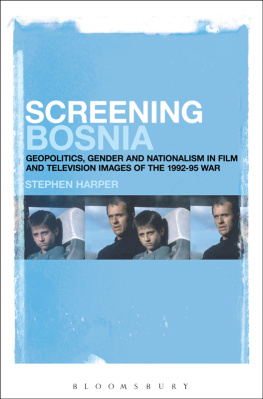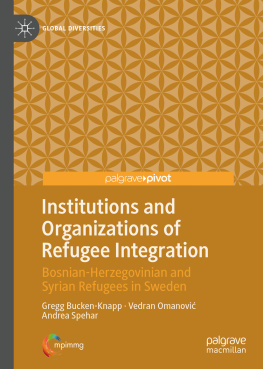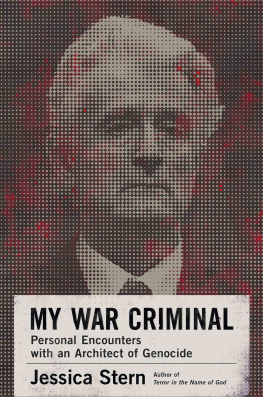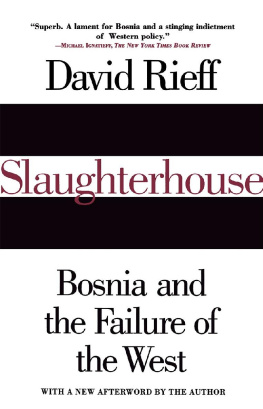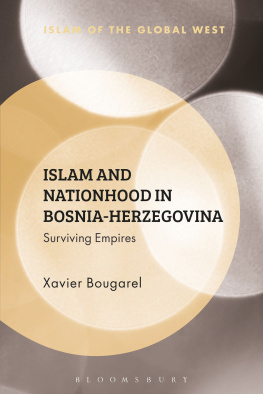

Copyright 2016 by ABC-CLIO, LLC
All rights reserved. No part of this publication may be reproduced, stored in a retrieval system, or transmitted, in any form or by any means, electronic, mechanical, photocopying, recording, or otherwise, except for the inclusion of brief quotations in a review, without prior permission in writing from the publisher.
Library of Congress Cataloging-in-Publication Data
Names: Bartrop, Paul R. (Paul Robert), 1955 editor.
Title: Bosnian genocide : the essential reference guide / Paul R. Bartrop, editor.
Description: Santa Barbara, California : ABC-CLIO, 2016.
Identifiers: LCCN 2015028983 | ISBN 9781440838682 (hardback) | ISBN 9781440838699 (ebook)
Subjects: LCSH: Yugoslav War, 19911995Atrocities. | GenocideBosnia and Herzegovina.
Classification: LCC DR1313.7.A85 .B675 2016 | DDC 949.703dc23
LC record available at http://lccn.loc.gov/2015028983
ISBN: 978-1-4408-3868-2
EISBN: 978-1-4408-3869-9
201918171612345
This book is also available on the World Wide Web as an eBook.
Visit www.abc-clio.com for details.
ABC-CLIO
An Imprint of ABC-CLIO, LLC
ABC-CLIO, LLC
130 Cremona Drive, P.O. Box 1911
Santa Barbara, California 93116-1911
This book is printed on acid-free paper 
Manufactured in the United States of America
To those who survived the horrors of the 1990s
and in memory
of those who did not.
Contents
Preface
On November 9, 1989, the Berlin Wall fell, precipitating massive political change throughout Central and Eastern Europe. One by one, communist regimes, many of which had already been destabilized by economic insecurities, collapsedin East Germany, Hungary, Poland, Czechoslovakia, Bulgaria, and Romania. Only Yugoslavia, which had not been part of the Soviet empire, remained of the Cold Warera communist states.
The future would be an agony of the worst kind; it would arrive through blood and fire, in tears and sorrow, seeing the very destruction of the countrywhich would ultimately be fragmented into seven new nation-states.
The disintegration of Yugoslavia began in 1991 and continued until 1999. The worst of the mayhem took place between 1992 and 1995, and culminatedin the 50th anniversary year of the end of World War IIwith the worst massacre on European soil since the Holocaust.
The entries in this book go a long way toward explaining how the conflict played out. They examine the leaders, ideas, movements, and events of the Bosnian War, placing the war into the earlier context of Yugoslavias history. As the forces unleashed by the collapse of Yugoslavia did not end in 1995, this book pursues the wars horrific aftermathone which led to another war in 1999, when the forces of the North Atlantic Treaty Organization combined to defeat the prospect of a further genocide, this time in the Serbian province of Kosovo.
It was a shocking way to usher in the new century but, as this had been the Century of Genocide, perhaps it was apt. After all, united international action to stop the possibility of genocide was at least an improvement on the inaction that had characterized nearly all responses across the previous hundred years.
The contributors to this volume have brought exacting standards to the task of enlightening readers as to what happened in this final paroxysm of 20th-century violence. In many cases, their task has been difficult, owing to the murky nature of the conflicts being examined. That said, it is hoped that the entries presented here will contribute to readers understanding of the period under discussion and the awful events of that time.
As editor of this volume, I would like to place on record just a few statements of thanks. Padraic (Pat) Carlin of ABC-CLIO suggested the project, and has at all times provided unstinting assistance with both good humor and forbearance. Many of my students at Florida Gulf Coast University showed interest as the project took shape, and I was fortunate in being offered the eager help of two in particular, Danielle Drew and Elizabeth Snyder. As always, Steven Leonard Jacobs from the University of Alabama and Michael Dickerman from Stockton University kept a watching brief on my physical and intellectual health throughout the process, and for their friendship I remain perpetually grateful.
Finally, as in all my projects, I cannot let the opportunity pass without conveying my ongoing thanks to my dear wife, Eve. She accompanied me on my first visit to Sarajevo in 2005, on the occasion of the 10th anniversary of the genocidal massacre at Srebrenica. Conquering her fears of entering what had so recently been a war zone, she not only braved Srebrenica, but together we survived the 7/7 terrorist attacks in London two days before we went to Bosnia. In many respects, this characterizes our relationship; for all that life can throw at us, and often despite the odds, we endure. May it be ever so.
List of Entries
List of Primary Source Documents
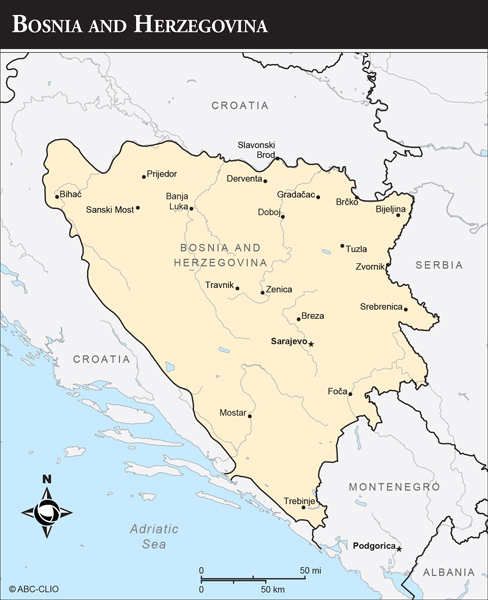


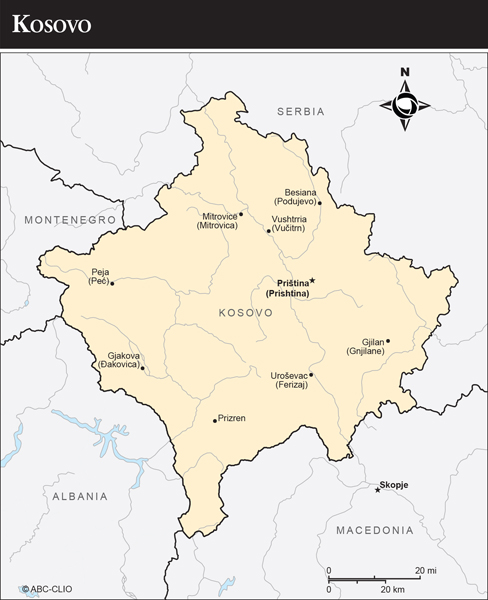
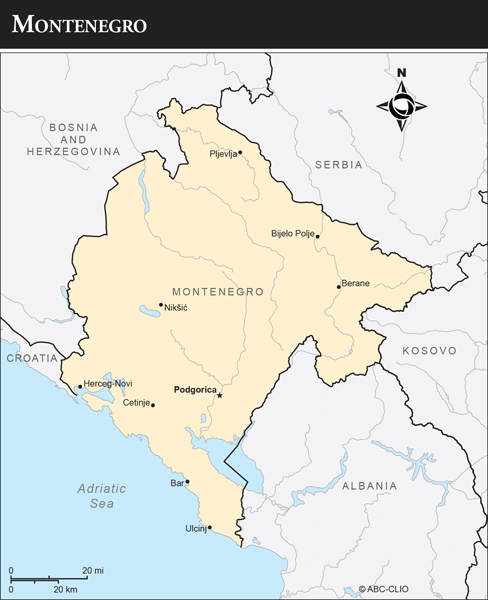
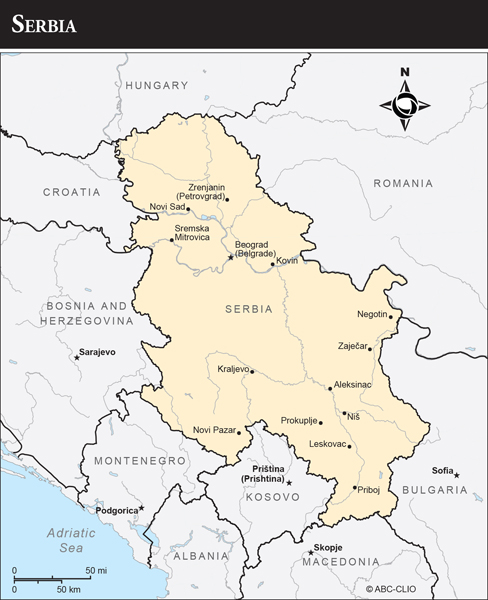
Bosnian Genocide Overview
Located in the Balkan Peninsula, Bosnia-Herzegovina is a geographically diverse country bordered by Croatia (to the north, west, and south), Serbia (east), and Montenegro (southeast). In the 1990s, Bosnia became the center of a policy of ethnic cleansing enacted by Serbian authorities in an attempt to create a more ethnically homogenous region amid the context of war.
The Socialist Federal Republic of Yugoslavia (19451992) united six equal statesCroatia, Montenegro, Serbia, Slovenia, Bosnia-Herzegovina, and Macedoniain Brotherhood and Unity, the national credo of Josip Broz Tito, the leader of Yugoslavia. Tito expected citizens to set aside ethno-national affiliation and embrace broader Yugoslav identity. A system of checks and balances ensured peace, cooperation, and equality among the regions peoples; and through common cultural roots and shared historical experiences pan-Slavic unity was emphasized. Most people were generally content with their identity as Yugoslavs. Yugoslavias comparatively open socialism, Cold War neutrality, and prominence in the Non-Aligned Movement allowed for relatively high living standards, unrestricted international travel, and flourishing cultural life. Moreover, Brotherhood and Unity particularly suited Bosnias multiethnic society, and Bosnia thrived in Titos prosperous and stable Yugoslavia, even hosting the 1984 Winter Olympics.
After nearly 40 years in power, Titos death in 1980 left a political vacuum. As the Soviet Bloc disintegrated, Yugoslavia lost global strategic importance and the economic opportunities of Cold War neutrality evaporated. By the mid-1980s, without strong national leadership, economic collapse loomed. Opportunistic politicians seized upon Yugoslavias instability, especially in Serbia and Croatia, rallying support through fear-based nationalist appeals. Slobodan Milosevic ascended to power in Serbia, blaming the ethnic other for the nations crises, using historical tragedies to imply impending contemporary threats (Ustashe Croats, Turk Bosniaks), and advocating Serbian unity as the solution. This fueled the ascension of his Croatian counterpart, Franjo Tudjman, whose equally reductionist nationalism increased instability and mistrust in Croatia. By 1990, Brotherhood and Unity had crumbled under the weight of xenophobic hysteria.
Next page
